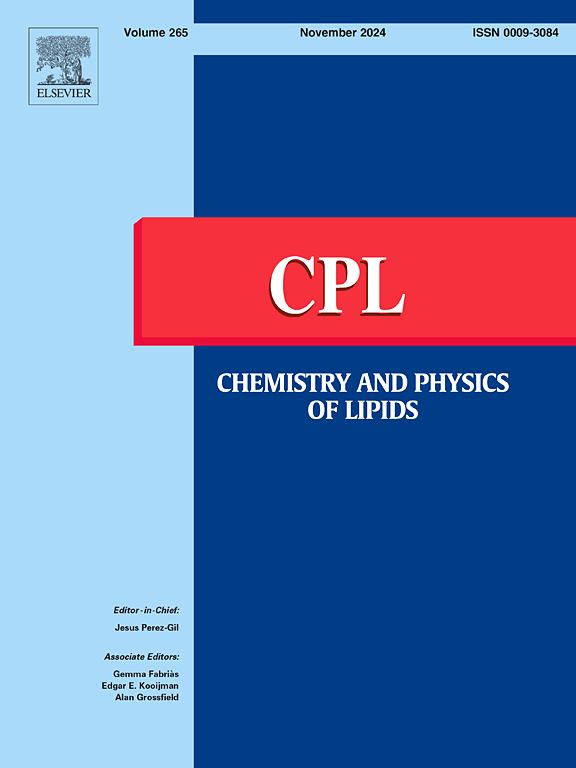Cholesterol and related sterols differentially modulate lipid domain dynamics in model membranes: A dual-probe analysis of domain-specific effects
IF 2.8
3区 生物学
Q2 BIOCHEMISTRY & MOLECULAR BIOLOGY
引用次数: 0
Abstract
The role of cholesterol in the organization and ordering of membrane domains has been well established over the past decades. However, the involvement of cholesterol precursors and byproduct sterols in modulating the physicochemical properties of cell membranes remains less thoroughly explored. In this study, we investigated the effects of cholesterol, two hydroxylated catabolites (24-hydroxycholesterol and 25-hydroxycholesterol), and two biosynthesis precursors (desmosterol and lanosterol) on model of liquid-ordered (Lo) and liquid-disordered (Ld) membrane domains. Membrane ordering and molecular mobility were assessed using two fluorescent probes; Laurdan, which senses polarity near the membrane aqueous interface and cholesterol-pyrene, which senses ordering closer to the center of the membrane bilayer. The results showed that Laurdan can distinguish between environmental polarity and the contribution of membrane domains. The probe mobility varied depending on the sterol and did not strictly correlate with membrane order. Cholesterol–pyrene revealed that the sterols induce varying degrees of ordering around the bilayer center. A notable observation in Ld membranes using different probes was that the ordering effect of sterols was similar near the lipid head groups and at the center of the bilayer. Hydroxycholesterols exhibited a low ordering effect, whereas cholesterol and desmosterol induced a strong effect. In contrast, in Lo membranes, hydroxycholesterols produced a strong ordering effect near the head groups but a reduced effect near the bilayer center.
胆固醇和相关的固醇在模型膜中差异调节脂质结构域动力学:结构域特异性效应的双探针分析。
在过去的几十年里,胆固醇在膜结构域的组织和排序中的作用已经得到了很好的证实。然而,胆固醇前体和副产物甾醇在调节细胞膜物理化学性质中的作用尚未得到充分探讨。在这项研究中,我们研究了胆固醇、两种羟基化分解产物(24-羟基胆固醇和25-羟基胆固醇)和两种生物合成前体(去氨甾醇和羊毛甾醇)对液体有序(Lo)和液体无序(Ld)膜结构域模型的影响。用两种荧光探针测定膜的有序性和分子迁移率;Laurdan在膜水界面附近感知极性,而胆固醇-芘在靠近膜双分子层中心的地方感知有序。结果表明,Laurdan能够区分环境极性和膜结构域的贡献。探针的迁移率随甾醇的变化而变化,与膜的顺序没有严格的相关性。胆固醇-芘表明,甾醇在双分子层中心周围诱导不同程度的有序。使用不同探针在Ld膜中观察到的一个值得注意的现象是,在脂质头基团附近和双分子层中心,甾醇的排序作用是相似的。羟基胆固醇表现出低排序效应,而胆固醇和去氨甾醇则表现出强排序效应。相反,在Lo膜中,羟基胆固醇在头基团附近产生强烈的排序效应,但在双层中心附近的作用减弱。
本文章由计算机程序翻译,如有差异,请以英文原文为准。
求助全文
约1分钟内获得全文
求助全文
来源期刊

Chemistry and Physics of Lipids
生物-生化与分子生物学
CiteScore
7.60
自引率
2.90%
发文量
50
审稿时长
40 days
期刊介绍:
Chemistry and Physics of Lipids publishes research papers and review articles on chemical and physical aspects of lipids with primary emphasis on the relationship of these properties to biological functions and to biomedical applications.
Accordingly, the journal covers: advances in synthetic and analytical lipid methodology; mass-spectrometry of lipids; chemical and physical characterisation of isolated structures; thermodynamics, phase behaviour, topology and dynamics of lipid assemblies; physicochemical studies into lipid-lipid and lipid-protein interactions in lipoproteins and in natural and model membranes; movement of lipids within, across and between membranes; intracellular lipid transfer; structure-function relationships and the nature of lipid-derived second messengers; chemical, physical and functional alterations of lipids induced by free radicals; enzymatic and non-enzymatic mechanisms of lipid peroxidation in cells, tissues, biofluids; oxidative lipidomics; and the role of lipids in the regulation of membrane-dependent biological processes.
 求助内容:
求助内容: 应助结果提醒方式:
应助结果提醒方式:


